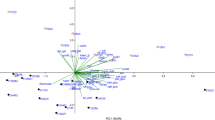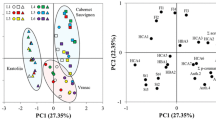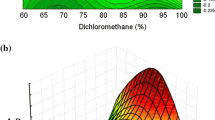Abstract
The aims were to determine the polyphenolic profile of red wines from Spanish Designation of Origin (DO) Rías Baixas and Ribeira Sacra and to evaluate the feasibility of using polyphenolic profiles and chemometric tools to classify wines for authentication purposes. Trans-resveratrol, oenin, malvin, (+)-catechin, (−)-epicatechin, quercetin and syringic acid were determined in 39 samples. Soft independent modeling of class analogy (SIMCA), linear discriminant analysis (LDA) and support vector machine classification (SVM) were used to classify. For resveratrol, Ribeira Sacra red wines showed higher values than Rías Baixas wines (4.60 and 3.36 mg L−1, respectively). SVM classification was adequate for 100 % classification of wines by their polyphenolic profile. SIMCA classification was also adequate for wine classification of DO Rías Baixas and Ribeira Sacra wines. As conclusion, polyphenolic profile can be used for classification of DOs. The models can discriminate outside wines. Thus, this approach can be useful for authentication purposes.




Similar content being viewed by others
References
Abdi H, Williams LJ (2010) Principal component analysis. Wiley Interdiscip Rev Comput Stat 2:433–459
Alarcon-Flores MI, Romero-Gonzalez R, Vidal JLM, Frenich AG (2013) Multiclass determination of phytochemicals in vegetables and fruits by ultra high performance liquid chromatography coupled to tandem mass spectrometry. Food Chem 141:1120–1129
Atanacković M, Petrović A, Jović S, Bukarica LG, Bursać M, Cvejić J (2012) Influence of winemaking techniques on the resveratrol content, total phenolic content and antioxidant potential of red wines. Food Chem 131:513–518
Bahrim G, Iancu C, Butu N, Negoita T (2010) Production of a novel microbial transglutaminase using Streptomyces sp. polar strains. Rom Biotechnol Lett 15:5197–5203
Basha SM, Musingo M, Colova VS (2005) Compositional differences in the phenolics compounds of muscadine and bunch grape wines. Afr J Biotechnol 3:523–528
Bayram B, Ozcelik B, Schultheiss G, Frank J, Rimbach G (2013) A validated method for the determination of selected phenolics in olive oil using high-performance liquid chromatography with coulometric electrochemical detection and a fused-core column. Food Chem 138:1663–1669
Belajova E (2012) Determination of selected wine phenolic constituents as possible markers for differentiation of wines. J Food Nutr Res 51:117–122
Boggia R, Casolino MC, Hysenaj V, Oliveri P, Zunin P (2013) A screening method based on UV-Visible spectroscopy and multivariate analysis to assess addition of filler juices and water to pomegranate juices. Food Chem 140:735–741
Bustos G, Moldes AB, Alonso JL, Vazquez M (2004) Optimization of D-lactic acid production by Lactobacillus coryniformis using response surface methodology. Food Microbiol 21:143–148
Callejón RM, Amigo JM, Pairo E, Garmón S, Ocaña JA, Morales ML (2012) Classification of Sherry vinegars by combining multidimensional fluorescence, parafac and different classification approaches. Talanta 88:456–462
Cetó X, Gutiérrez-Capitán M, Calvo D, del Valle M (2013) Beer classification by means of a potentiometric electronic tongue. Food Chem 141:2533–2540
Chouchouli V, Kalogeropoulos N, Konteles SJ, Karvela E, Makris DP, Karathanos VT (2013) Fortification of yoghurts with grape (Vitis vinifera) seed extracts. LWT-Food Sci Technol 53:522–529
Cotea VV, Luchian CE, Bilba N, Niculaua M (2012) Mesoporous silica SBA-15, a new adsorbent for bioactive polyphenols from red wine. Anal Chim Acta 732:180–185
Cozzolino D, Cynkar WU, Shah N, Smith P (2011) Multivariate data analysis applied to spectroscopy: potential application to juice and fruit quality. Food Res Int 44:1888–1896
Crupi P, Pichierri A, Basile T, Antonacci D (2013) Postharvest stilbenes and flavonoids enrichment of table grape cv Redglobe (Vitis vinifera L.) as affected by interactive UV-C exposure and storage conditions. Food Chem 141:802–808
De Nisco M, Manfra M, Bolognese A, Sofo A, Scopa A, Tenore GC, Pagano F, Milite C, Russo MT (2013) Nutraceutical properties and polyphenolic profile of berry skin and wine of Vitis vinifera L. (cv. Aglianico). Food Chem 140:623–629
de Quirós AR, López-Hernández J, Lage-Yusty M (2008) Liquid chromatographic determination of malvidin-3-O-glucoside and malvidin 3, 5-O-diglucoside in wine samples by direct injection. Open Food Sci J 2:68–71
Dias FD, Klassen A, Tavares MFM, David JM (2013a) Fast determination of phenolic compounds in Brazilian wines from Vale do So Francisco Region by CE. Chromatographia 76:559–563
Dias FD, Silva MF, David JM (2013b) Determination of quercetin, gallic acid, resveratrol, catechin and malvidin in Brazilian wines elaborated in the Vale do So Francisco using liquid-liquid extraction assisted by ultrasound and GC-MS. Food Anal Methods 6:963–968
Diaz-Garcia M, Obon JM, Castellar MR, Collado J, Alacid M (2013) Quantification by UHPLC of total individual polyphenols in fruit juices. Food Chem 138:938–949
Esparza I, Santamaria C, Calvo I, Fernandez JM (2009) Significance of CIELAB parameters in the routine analysis of red wines Relevancia de los parametros CIELAB en el analisis de rutina de vinos tintos. CyTA-J Food 7:189–199
Feijoo O, Moreno A, Falque E (2008) Content of trans- and cis-resveratrol in Galician white and red wines. J Food Compos Anal 21:608–613
Ferrer-Gallego R, Hernandez-Hierro J, Rivas-Gonzalo J, Escribano-Bailon M (2011) Multivariate analysis of sensory data of Vitis vinifera L. cv. Graciano during ripening. Correlation with the phenolic composition of the grape skins. CyTA-J Food 9:290–294
Figueiredo-González M, Martínez-Carballo E, Cancho-Grande B, Santiago JL, Martínez MC, Simal-Gándara J (2012) Pattern recognition of three Vitis vinifera L. red grapes varieties based on anthocyanin and flavonol profiles, with correlations between their biosynthesis pathways. Food Chem 130:9–19
Fiori L, de Faveri D, Casazza AA, Perego P (2009) Grape by-products: extraction of polyphenolic compounds using supercritical CO2 and liquid organic solvent—a preliminary investigation Subproductos de la uva: extraccion de compuestos polifenolicos usando CO2 supercritico y disolventes organicos liquidos - una investigacion preliminar. CyTA-J Food 7:163–171
Fudge AL, Wilkinson KL, Ristic R, Cozzolino D (2013) Synchronous two-dimensional MIR correlation spectroscopy (2D-COS) as a novel method for screening smoke tainted wine. Food Chem 139:115–119
Gomez Gallego MA, Sanchez-Palomo E, Hermosin-Gutierrez I, Gonzalez Vinas MA (2013) Polyphenolic composition of Spanish red wines made from Spanish Vitis vinifera L. red grape varieties in danger of extinction. Eur Food Res Technol 236:647–658
Jiang B, Zhang ZW (2012) Comparison on phenolic compounds and antioxidant properties of Cabernet Sauvignon and Merlot wines from four wine grape-growing regions in China. Molecules 17:8804–8821
Keckes S, Gasic U, Velickovic TC, Milojkovic-Opsenica D, Natic M, Tesic Z (2013) The determination of phenolic profiles of Serbian unifloral honeys using ultra-high-performance liquid chromatography/high resolution accurate mass spectrometry. Food Chem 138:32–40
Lorrain B, Tempere S, Iturmendi N, Moine V, de Revel G, Teissedre PL (2013) Influence of phenolic compounds on the sensorial perception and volatility of red wine esters in model solution: an insight at the molecular level. Food Chem 140:76–82
Lutz M, Cajas Y, Henriquez C (2012) Phenolics content and antioxidant capacity of Chilean grapes cv. Pais and Cabernet Sauvignon. CyTA-J Food 10:251–257
Martelo-Vidal MJ, Vázquez M (2014) Determination of polyphenolic compounds of red wines by UV–VIS-NIR spectroscopy and chemometrics tools. Food Chem 158:28–34
Martelo-Vidal M, Dominguez-Agis F, Vazquez M (2013) Ultraviolet/visible/near-infrared spectral analysis and chemometric tools for the discrimination of wines between subzones inside a controlled designation of origin: a case study of Rias Baixas. Aust J Grape Wine Res 19:62–67
Martin S, Gonzalez-Burgos E, Carretero ME, Gomez-Serranillos M (2013) Protective effects of Merlot red wine extract and its major polyphenols in Pc12 cells under oxidative stress conditions. J Food Sci 78:H112–H118
Melendez E, Ortiz MC, Sarabia LA, Iniguez M, Puras P (2013) Modelling phenolic and technological maturities of grapes by means of the multivariate relation between organoleptic and physicochemical properties. Anal Chim Acta 761:53–61
Mulero J, Pardo F, Zafrilla P (2010) Antioxidant activity and phenolic compounds in conventional and organic red grapes (var. Monastrell). CyTA-J Food 8:185–191
Murtaza G, Latif U, Najam-Ul-Haq M, Sajjad A, Karim S, Akhtar M, Hussain I (2013) Resveratrol: an active natural compound in red wines for health. J Food Drug Anal 21:1–12
Ouyang Q, Zhao JW, Chen QS (2013) Classification of rice wine according to different marked ages using a portable multi-electrode electronic tongue coupled with multivariate analysis. Food Res Int 51:633–640
Panzella L, Petriccione M, Rega P, Scortichini M, Napolitano A (2013) A reappraisal of traditional apple cultivars from southern Italy as a rich source of phenols with superior antioxidant activity. Food Chem 140:672–679
Pascoa R, Magalhaes LM, Lopes JA (2013) FT-NIR spectroscopy as a tool for valorization of spent coffee grounds: application to assessment of antioxidant properties. Food Res Int 51:579–586
Pedroza MA, Carmona M, Pardo F, Salinas MR, Zalacain A (2012) Waste grape skins thermal dehydration: potential release of colour, phenolic and aroma compounds into wine. CyTA-J Food 10:225–234
Restaino E, Fassio A, Cozzolino D (2011) Discrimination of meat pates according to the animal species by means of near infrared spectroscopy and chemometrics. CyTA-J Food 9:210–213
Rudnitskaya A, Rocha SM, Legin A, Pereira V, Marques JC (2010) Evaluation of the feasibility of the electronic tongue as a rapid analytical tool for wine age prediction and quantification of the organic acids and phenolic compounds. The case-study of Madeira wine. Anal Chim Acta 662:82–89
Rusendi D, Sheppard JD (1995) Hydrolysis of potato processing waste for the production of poly-beta-hydroxybutyrate. Bioresour Technol 54:191–196
Stewart LK, Soileau JL, Ribnicky D, Wang ZQ, Raskin I, Poulev A, Majewski M, Cefalu WT, Gettys TW (2008) Quercetin transiently increases energy expenditure but persistently decreases circulating markers of inflammation in C57BL/6J mice fed a high-fat diet. Metab Clin Exp 57:S39–S46
Toaldo IM, Fogolari O, Pimentel GC, de Gois JS, Borges DLG, Caliari V, Bordignon-Luiz M (2013) Effect of grape seeds on the polyphenol bioactive content and elemental composition by ICP-MS of grape juices from Vitis labrusca L. LWT-Food Sci Technol 53:1–8
Tuberoso CIG, Boban M, Bifulco E, Budimir D, Pirisi FM (2013) Antioxidant capacity and vasodilatory properties of Mediterranean food: the case of Cannonau wine, myrtle berries liqueur and strawberry-tree honey. Food Chem 140:686–691
Conflict of Interest
Maria J. Martelo-Vidal declares that she has no conflict of interest. Manuel Vázquez declares that he has no conflict of interest. This article does not contain any studies with human or animal subjects.
Author information
Authors and Affiliations
Corresponding author
Rights and permissions
About this article
Cite this article
Martelo-Vidal, M.J., Vázquez, M. Polyphenolic Profile of Red Wines for the Discrimination of Controlled Designation of Origin. Food Anal. Methods 9, 332–341 (2016). https://doi.org/10.1007/s12161-015-0193-8
Received:
Accepted:
Published:
Issue Date:
DOI: https://doi.org/10.1007/s12161-015-0193-8




